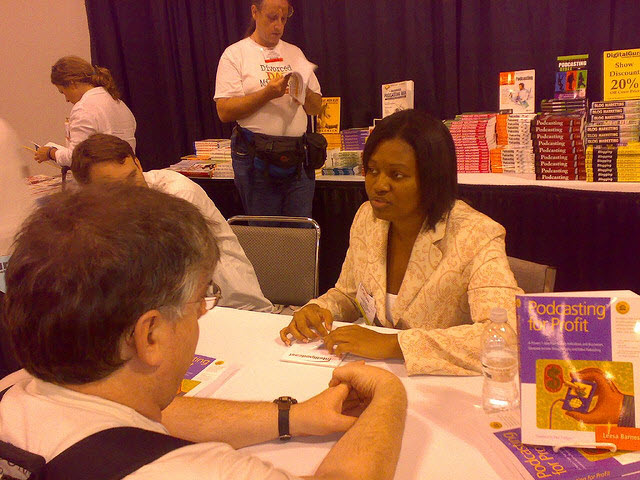I truly feel like I’m at the Oscars. People are scheduling meetups, after parties and networking sessions before, after and during the Podcast & Portable Media Expo (PME).
I now see the importance of attending industry specific conferences, whether I’m a speaker or not. You learn about new advances in your industry, but the invaluable part comes from the general schmoozing that happens after the sessions are over.
I’m a huge believer in technology. It runs my business. My podcast has helped me to make money. My blog has helped me to build my platform. I use technology to help companies market their brands and control their message. Technology has helped me to develop relationships with people who don’t even live in my country, often with journalists who were once unreachable. It’s a wonderful world to be in.
Yet, despite these benefits, nothing can take the place of the tangible interaction. Nothing. It’s the reason why newspapers, magazines and books will always exist. It’s the reason why expos, conferences and unconferences will always happen. Human contact with tangible things is valued above everything else.
One could argue that leaving a comment on a blog or calling a comment line to voice your feedback is tangible interaction. Sure, but there’s a delay, in essence, this can be called delayed interaction. You don’t get to read the person’s body language or see the unspoken nuances that come with tangible interaction. With delayed interaction, the spontaneity is missed. And what does Malcolm Gladwell say about this in his book Blink?
At first, I thought it was a generational thing. A man I know who is an entrepreneur and is now my client, insisted that we meet in person before he signed up with me.
He’s a baby boomer and I know that their generation doesn’t trust the automation process. Part of it is because they don’t understand, but a huge part is because it’s much more personal to deal with the person than the machine.
My dad, for example, is on the leading edge of the boomers. He just turned 59 and he refuses to use a bank machine. He’d rather go line up and be face-to-face with a teller.
He’s banked at the same branch for 22-years and anytime he walks in, he’s treated like a super star. My sister said that she went in with him recently and she was shocked at how giddy some of the female tellers acted. One even opened her booth and called my dad over just so he didn’t have to line up.
Think about teenagers and MySpace. There have been many stories of teenagers flying across the country to meet with a person whom they’ve developed a relationship with. Of course, for many of these stories the person waiting was a pedophile, but my point is that tangible interaction is what drives us to connect.
This all comes back to a sense of belonging. While I feel that I belong to a group of thought leaders in the media and marketing community here in Canada, I jump at the chance when someone organizes a dinner and invites me to attend. Here I am sitting in Ontario, California and I’m busy calling people to find out when they arrive just so I have people to have lunch with.
Seeing someone’s smile, seeing how they walk, noticing the quirky way they talk may seem like a recipe for a really great romance, but it’s actually a way that people connect. Belonging is what will keep these relationships going and it’s the reason why we’ll continue to go to conferences and expos, even though technology connects us much more easily and cheaply.
Technorati: podcasting, Blogging, technology, Business, conferences, Travel, pme, portable media expo



0 Comments